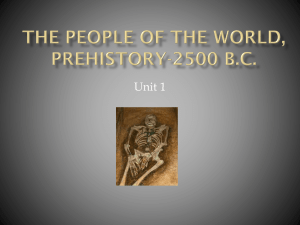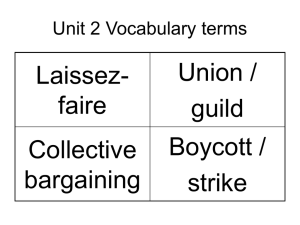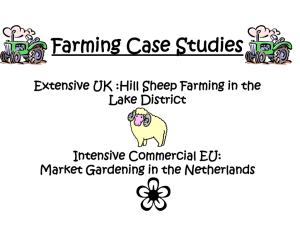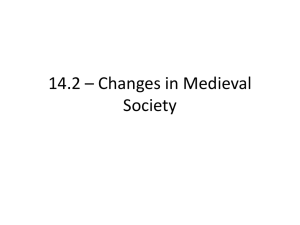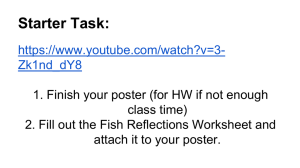con501: application to use land for farming activity
advertisement
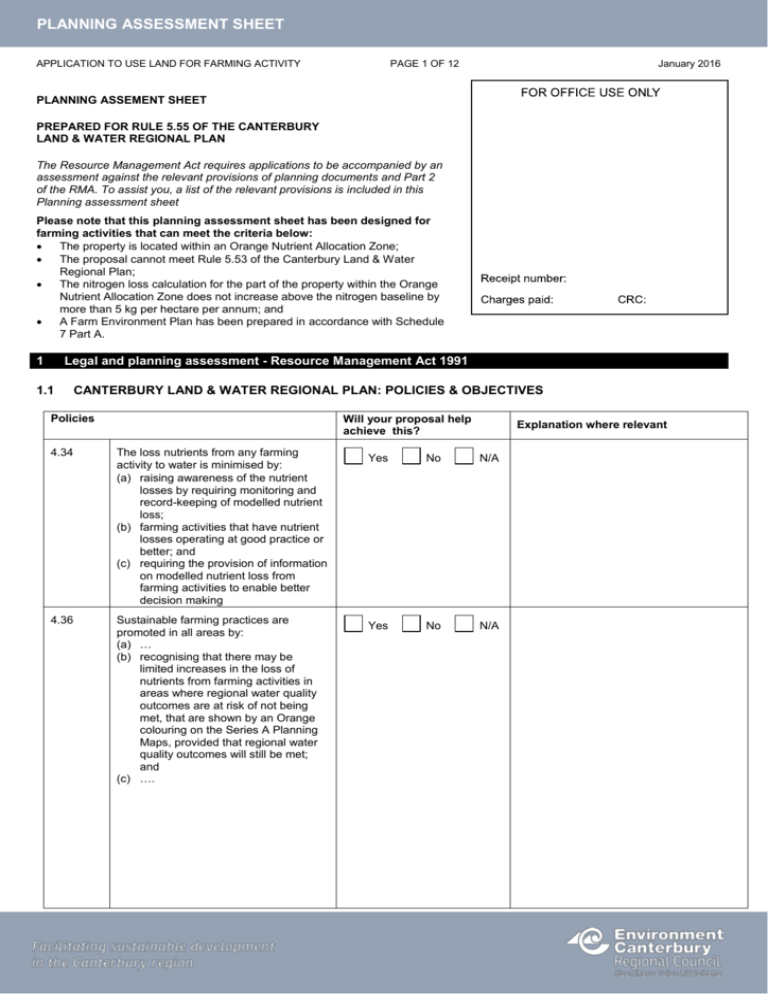
PLANNING ASSESSMENT SHEET APPLICATION TO USE LAND FOR FARMING ACTIVITY PAGE 1 OF 12 January 2016 PLANNING ASSEMENT SHEET PREPARED FOR RULE 5.55 OF THE CANTERBURY LAND & WATER REGIONAL PLAN The Resource Management Act requires applications to be accompanied by an assessment against the relevant provisions of planning documents and Part 2 of the RMA. To assist you, a list of the relevant provisions is included in this Planning assessment sheet Please note that this planning assessment sheet has been designed for farming activities that can meet the criteria below: The property is located within an Orange Nutrient Allocation Zone; The proposal cannot meet Rule 5.53 of the Canterbury Land & Water Regional Plan; The nitrogen loss calculation for the part of the property within the Orange Nutrient Allocation Zone does not increase above the nitrogen baseline by more than 5 kg per hectare per annum; and A Farm Environment Plan has been prepared in accordance with Schedule 7 Part A. 1 Legal and planning assessment - Resource Management Act 1991 1.1 CANTERBURY LAND & WATER REGIONAL PLAN: POLICIES & OBJECTIVES Policies Will your proposal help achieve this? 4.34 The loss nutrients from any farming activity to water is minimised by: (a) raising awareness of the nutrient losses by requiring monitoring and record-keeping of modelled nutrient loss; (b) farming activities that have nutrient losses operating at good practice or better; and (c) requiring the provision of information on modelled nutrient loss from farming activities to enable better decision making 4.36 Sustainable farming practices are promoted in all areas by: (a) … (b) recognising that there may be limited increases in the loss of nutrients from farming activities in areas where regional water quality outcomes are at risk of not being met, that are shown by an Orange colouring on the Series A Planning Maps, provided that regional water quality outcomes will still be met; and (c) …. Explanation where relevant Yes No N/A Yes No N/A PLANNING ASSESSMENT SHEET APPLICATION TO USE LAND FOR FARMING ACTIVITY PAGE 2 OF 12 January 2016 Will your proposal help achieve this? 4.38 Require the adoption of the best practicable options to minimise the loss of nutrients from farming activities in areas where region-wide water quality outcomes are at risk of not being met, that are shown by an Orange colouring on the Series A Planning Maps. 4.40 Farm Environment Plans are used as a primary means of identifying and delivering good environmental practice across a range of farm activities, including nutrient loss management, efficient and effective use of water for irrigation, riparian management, stock movements across waterways, offal and farm rubbish pits, the storage and application of effluent and fertiliser use. 4.41 Applications for resource consents for farming activities will be accompanied by a Farm Environment Plan that has been prepared in accordance with Schedule 7 and the conditions of any resource consent granted will specify: Explanation where relevant Yes No N/A Yes No N/A Yes No N/A (a) procedures and criteria for the timely review and updating of the Farm Environment Plan; (b) a requirement to meaningfully implement the Farm Environment Plan; (c) monitoring and information provision; and (d) requirements for the independent auditing of the Farm Environment Plan and the remedying of compliance issues raised in the audit. Objectives 3.1 Land and water are managed as integrated natural resources to recognise and enable Ngāi Tahu culture, traditions, customary uses and relationships with land and water. 3.6 Water is recognised as essential to all life and is respected for its intrinsic values. 3.7 Fresh water is managed prudently as a shared resource with many in-stream and out-of-stream values. Will your proposal help achieve this? Explanation where relevant Yes No N/A Yes No N/A Yes No N/A PLANNING ASSESSMENT SHEET APPLICATION TO USE LAND FOR FARMING ACTIVITY 3.8 The quality and quantity of water in fresh water bodies and their catchments is managed to safeguard the lifesupporting capacity of ecosystems and ecosystem processes, including ensuring sufficient flow and quality of water to support the habitat and feeding, breeding, migratory and other behavioural requirements of indigenous species, nesting birds and, where appropriate, trout and salmon. 3.8A High quality fresh water is available to meet actual and reasonably foreseeable needs for community drinking water supplies. 3.14 Outstanding fresh water bodies and hāpua and their margins are maintained in a healthy state or are improved where degraded. 3.15 Those parts of lakes and rivers that are valued by the community for recreation are suitable for contact recreation. 3.17 3.23 PAGE 3 OF 12 January 2016 Yes No N/A Yes No N/A Yes No N/A Yes No N/A The significant indigenous biodiversity values of rivers, wetlands and hāpua are protected. Yes No N/A Soils are healthy and productive, and human-induced erosion and contamination are minimised. Yes No N/A PLANNING ASSESSMENT SHEET APPLICATION TO USE LAND FOR FARMING ACTIVITY 3.24 1.2 PAGE 4 OF 12 All activities operate at “good environmental practice” or better to optimise efficient resource use and protect the region’s fresh water resources from quality and quantity degradation. Yes January 2016 No N/A NATIONAL POLICY STATEMENT (NPS) FOR FRESHWATER MANAGEMENT 2014 The proposed activity will be consistent with the objectives of the NATIONAL POLICY STATEMENT (NPS) FOR FRESHWATER 2014 as the 2011 NPS was given effect to through the objectives, policies and rules in the CANTERBURY LAND & WATER REGIONAL PLAN and the objectives remained unchanged when amended in 2014. 1.3 RESOURCE MANAGEMENT (NATIONAL ENVIRONMENTAL STANDARDS FOR SOURCES OF HUMAN DRINKING WATER) REGULATIONS 2007 The proposed activity will be consistent with the NATIONAL ENVIRONMENTAL STANDARDS FOR SOURCES OF HUMAN DRINKING WATER) REGULATIONS 2007 as it was given effect to through the objectives, policies and rules in the CANTERBURY LAND & WATER REGIONAL PLAN. 1.4 CANTERBURY REGIONAL POLICY STATEMENT 2013 The proposed activity will be consistent with the objectives of the CANTERBURY REGIONAL POLICY STATEMENT as it was given effect to through the objectives, policies and rules in the CANTERBURY LAND & WATER REGIONAL PLAN. 1.5 RESOURCE MANAGEMENT ACT PART 2 - PURPOSE AND PRINCIPLES 1.5.1 Section 5 – Purpose Sub-section The purpose of this Act is to promote the sustainable management of natural and physical resources. In this Act, sustainable management means managing the use, development, and protection of natural and physical resources in a way, or at a rate, which enables people and communities to provide for their social, economic, and cultural wellbeing and for their health and safety while— (a) Sustaining the potential of natural and physical resources (excluding minerals) to meet the reasonably foreseeable needs of future generations; and (b) Safeguarding the life-supporting capacity of air, water, soil, and ecosystems; and (c) Avoiding, remedying, or mitigating any adverse effects of activities on the environment. Is your activity consistent with this? Yes No N/A Explanation where relevant PLANNING ASSESSMENT SHEET APPLICATION TO USE LAND FOR FARMING ACTIVITY PAGE 5 OF 12 January 2016 1.5.2 Section 6 - Matters of national importance Does your activity recognise and provide for these? Recognise and provide for the following: a. b. c. d. e. f. g. Yes No Explanation where relevant N/A the preservation of the natural character of the coastal environment, wetlands, and lakes and rivers and their margins, and the protection of them from inappropriate subdivision, use, and development. the protection of outstanding natural features and landscapes from inappropriate subdivision, use, and development. the protection of areas of significant indigenous vegetation and significant habitats of indigenous fauna. the maintenance and enhancement of public access to and along the coastal marine area, lakes and rivers. the relationship of Maori and their culture and traditions with their ancestral lands, water, sites, wahi tapu, and other taonga. the protection of historic heritage from inappropriate subdivision, use, and development. the protection of recognised customary activities. 1.5.3 Section 7 - Other matters Have particular regard to the following: a. kaitiakitanga. aa. the ethic of stewardship. b. the efficient use and development of natural and physical resources. ba. the efficiency of the end use of energy. c. the maintenance and enhancement of amenity values. d. intrinsic values of ecosystems. e. (repealed) f. maintenance and enhancement of the quality of the environment. g. any finite characteristics of natural and physical resources. h. the protection of the habitat of trout and salmon. i. the effects of climate change. j. the benefits to be derived from the use and developments of renewable energy. Has your activity had regard to these? Yes No Explanation where relevant N/A 1.5.4 Section 8 - Treaty of Waitangi Has your activity taken into account these? Yes Take into account the principles of the Treaty of Waitangi. The Court of Appeal has identified four principles, which form the basis of developing a relationship of partnership and communication. These are the Essential Bargain, Tribal SelfRegulation, The Treaty Relationship, and Active Protection. No N/A Explanation where relevant PLANNING ASSESSMENT SHEET APPLICATION TO USE LAND FOR FARMING ACTIVITY PAGE 6 OF 12 January 2016 SECTION TWO: RELEVANT KAUPAPA (POLICIES) AND OBJECTIVES FROM NGĀI TAHU IWI MANAGEMENT PLANS (IMPs) 2 As part of your application (required under s88 of the Resource Management Act), you should consider your proposal against the policies (kaupapa) and objectives of the relevant IMPs for your location. The Ngāi Tahu Freshwater Policy Statement applies to all areas of Canterbury. You should therefore assess your activity against all of the listed policies and objectives. Next determine the relevant Papatipu rūnanga in relation to your farm and assess your activity against the policies and objectives listed under the relevant IMP. . Note: Please refer to http://canterburymaps.govt.nz/ and search “Farming Activity Resource Consents” to find information on areas of Papatipu rūnanga Papatipu Rūnanga Name of IMP Areas applies to Kaikōura Te Poha O Tohu Raumati Hapuku River to the Conway River Te Taumutu, Te Ngāi Tūāhuriri, Te Hapū o Ngāti Wheke (Rāpaki), Ōnuku, Koukourārata, & Wairewa Rūnanga Arowhenua & Waihao Rūnanga Moeraki & Waihao 2.1 Mahaanui Iwi Management Plan Iwi Management Plan of Kati Huirapa for the area Rakaia to Waitaki Kai Tahu Ki Otago Natural Resource Management Plan Sub-section of this form to be completed 2.2.1 Conway River to the Hurunui River and inland to the main divide 2.2.2 Coastal area From the Hurunui River to the Hakatere/ Ashburton River 2.2.3 2.3 Rakaia to Waitaki Rivers 2.4 Waitaki Catchment 2.5 NGĀI TAHU FRESHWATER POLICY STATEMENT (ALL AREAS OF CANTERBURY) Will your proposal assist in achieving this? Kaupapa Maui objective Restore, maintain and protect the mauri of freshwater resources Yes No N/A Mahinga kai objective To maintain vital, healthy mahinga kai populations and habitats capable of sustaining harvesting activity. Yes No N/A Mahinga kai Policy 3 Ensure that activities in the upper catchments have no adverse effect on mahinga kai resources in the lower catchments. Yes No N/A Explanation where relevant PLANNING ASSESSMENT SHEET APPLICATION TO USE LAND FOR FARMING ACTIVITY 2.2 PAGE 7 OF 12 January 2016 IMP: TE POHA O TOHU RAUMATI (WITHIN TAKIWĀ OF KAIKŌURA RŪNANGA) 2.2.1 Area: Hapuku River to the Conway River Will your proposal assist in achieving this? Kaupapa Farming – Policy 2 To encourage the adoption of “best practice” farming methods as part of developing environmentally sustainable, socially responsible, and economically viable farming systems. Farming – Policy 3 The kinds of farming activities that occur in a given area (land use) must match land capability (e.g. elevation, slope, soil type). Farming – Policy 4 To avoid the establishment or continuance of any use or activity that has the potential to result in the contamination of land or water unless effective precautions have been taken to avoid adverse effects on the environment. Farming – Policy 7 To require that the relationship between land use activities in upper catchments Yes No N/A Yes No N/A Yes No N/A Yes No N/A Yes No N/A and the health of coastal ecosystems is recognised and provided for in all decision making relating to coastal environment. Water Quality – Policy 6 To avoid adverse impacts on water quality as a result of non-point source pollution, and require that any non-avoidable impacts are mitigated. Water Quality – Policy 10 To maintain standards of water quality that ensure healthy mahinga kai populations capable of sustaining customary use. Yes No N/A Rivers, streams and creeks – General – Policy 2 To restore, maintain and protect the mauri of freshwater resources. Yes No N/A Cultural Landscapes – Policy 2 Applications for activities that are within, adjacent to, or may impact on a Statutory Acknowledgement (SA), Tōpuni, or any Deed of Settlement site will require consultation with both Te Rūnanga o Kaikōura and Te Rūnanga o Ngāi Tahu. Yes No N/A Explanation where relevant PLANNING ASSESSMENT SHEET APPLICATION TO USE LAND FOR FARMING ACTIVITY 2.2.2 PAGE 8 OF 12 January 2016 Area: Conway River to the Hurunui River and inland to the main divide Will your proposal assist in achieving this? Kaupapa Papatūāknuku – Soil conservation – Policy 7 To encourage the development of environmentally sustainable farming systems. Papatūāknuku – Soil conservation – Policy 9 The kinds of land use activities (e.g. type of farming) that occur in a given area must match land capability (e.g. elevation, slope, soil type), in order to protect soil resources. Papatūāknuku – Soil conservation – Policy 11 To advocate that all consents that effect soils are issued for a maximum of no Water quality – Policy 6 To require that the relationship between land use activities in upper catchments Yes No N/A Yes No N/A Yes No N/A Yes No N/A Yes No N/A Yes No N/A Yes No N/A more than 10 years. and the health of coastal ecosystems is recognised and provided for in all decision making relating to coastal environment. Water Quality – Policy 6 To avoid adverse impacts on water quality as a result of non-point source pollution, and require that any non-avoidable impacts are mitigated. Water quality – Policy 11 To maintain standards of water quality that ensure healthy mahinga kai populations capable of sustaining customary use. Water quality – Policy 17 To recommend that landowners be required to monitor nitrogen levels, to prevent overloading and adverse effects on water quality. Explanation where relevant PLANNING ASSESSMENT SHEET APPLICATION TO USE LAND FOR FARMING ACTIVITY Tūtae Putaputa (Conway River) – Policy 2 Applications for activities that are within, adjacent to, or may impact on the Tūtae Putaputa Statutory Acknowledgement (SA) area under the NTCSA 1998 will require consultation with both Te Rūnanga o Kaikōura and Te Rūnanga o Ngāi Tahu. Tūtae Putaputa (Conway River) – Policy 4 To ensure that activities in the Tūtae Putaputa catchment do not adversely impact the wāhi tapu and wāhi taonga values associated with Tūtae Putaputa. Tūtae Putaputa (Conway River) – Policy 6 To maintain standards of water quality that ensure healthy mahinga kai populations capable of sustaining customary use. Tūtae Putaputa (Conway River) – Policy 19 To ensure that activities in the upper catchment have no adverse effect on mahinga kai, water quality and water quantity in the lower catchment. 2.2.3 PAGE 9 OF 12 January 2016 Yes No N/A Yes No N/A Yes No N/A Yes No N/A Area: Coastal Will your proposal assist in achieving this? Kaupapa Farming in coastal areas – Policy 1 To protect lowland coastal areas from dairy conversion and other intensive farming activity. Low impact pastoral farming, with appropriate stocking rates and good land stewardship is considered the only acceptable farming activity in coastal areas, where such activities are appropriate at all. Farming in coastal areas – Policy 2 To encourage the adoption of “best practice” farming methods as part of developing environmentally sustainable, socially responsible, and economically viable farming systems. Yes No N/A Yes No N/A Explanation where relevant PLANNING ASSESSMENT SHEET APPLICATION TO USE LAND FOR FARMING ACTIVITY Farming in coastal areas – Policy 3 To avoid the establishment or continuance of any use or activity that has the potential to result in the contamination of land or water unless effective precautions have been taken to avoid adverse effects on the environment. Farming in coastal areas – Policy 4 The kinds of farming activities that occur in a given area (land use) should match land capability (e.g. elevation, slope, soil type). 2.3 PAGE 10 OF 12 January 2016 Yes No N/A Yes No N/A IMP: MAHAANUI (WITHIN TAKIWĀ OF TE TAUMUTU, TE NGĀI TŪĀHURIRI, TE HAPŪ O NGĀTI WHEKE (RĀPAKI), ŌNUKU, KOUKOURĀRATA, & WAIREWA RŪNANGA) 2.3.1 Area: Hurunui River to Hakatere/ Ashburton River Will your proposal assist in achieving this? Kaupapa Wai Māori Policy WM7.1 Wai Māori Policy WM7.2 To require that rural land and water planning, management and use recognises and provides for: a. Catchment boundaries and water availability; b. Water quality and quantity thresholds and limits; c. Land capability, including soil type and topography; d. The protection of eco-cultural systems and resources;and e. The capacity of a catchment to assimilate land use effects. To require a precautionary approach to the land use conversion and intensification in the takiwā that recognises and provides for: a. Existing and future effects of diffuse source pollution on surface and groundwater resources from land use; b. The cumulative effects of land use on the health of soil and water resources; and c. The cultural and environmental costs of land conversion and intensification, in addition to economic return per hectare. Yes No N/A Yes No N/A Explanation where relevant PLANNING ASSESSMENT SHEET APPLICATION TO USE LAND FOR FARMING ACTIVITY Wai Māori Policy .10 To promote on-farm measures that maximise water use efficiencies and reduce nutrient loss, and that enable landowners undertaking intensive rural PAGE 11 OF 12 January 2016 Yes No N/A Yes No N/A Yes No N/A Yes No N/A farming activities to be responsible for the cultural and environmental costs of their activities, including but not limited to: a. b. c. d. e. f. g. h. The treatment of effluent before disposal; On-farm nutrient management; Appropriate stocking rates, that avoid soil loss and nutrient leaching; Soil and foliage testing to optimise and minimise fertiliser use; Best practice irrigation management; The protection, construction or restoration of environmental infrastructure such as wetlands and riparian margins; and Fencing off surface waterways. Papatūanuku - Policy P2.1 Rural land use must prioritise the protection of resources and environmental health for future generations. Economic gain must not have priority over the maintenance of the mauri of Papatūānuku, the provider of all things of nature and the world. Papatūanuku - Policy P9.3 To protect the land from induced soil erosion as a result of unsustainable land use and development. Waimakariri Policy WAI3.3 To protect groundwater resources in the Waimakariri catchment from effects as a result of inappropriate or unsustainable land use and discharge to land activities. (Only applicable to the Waimakariri catchment) PLANNING ASSESSMENT SHEET APPLICATION TO USE LAND FOR FARMING ACTIVITY 2.4 January 2016 IMP: IWI MANAGEMENT PLAN OF KATI HUIRAPA FOR THE AREA RAKAIA TO WAITAKI (TAKIWĀ OF BOTH AROWHENUA & WAIHAO RŪNANGA) (Area: Rakaia to Waitaki Rivers) Will your proposal assist in achieving this? Kaupapa Part One – Land, Water and Air Policies 2.5 PAGE 12 OF 12 All waters to be the highest classified standard of water quality, with no waste discharges. Yes No Explanation where relevant N/A IMP: KAI TAHU KI OTAGO NATURAL RESOURCE MANAGEMENT PLAN (TAKIWĀ OF BOTH MOERAKI & WAIHAO RŪNANGA) Area: Waitaki Catchment Will your proposal assist in achieving this? Kaupapa Wai Maori General Policies – Policy 1 To require an assessment of instream values for all activities affecting water. Yes No N/A Explanation where relevant



